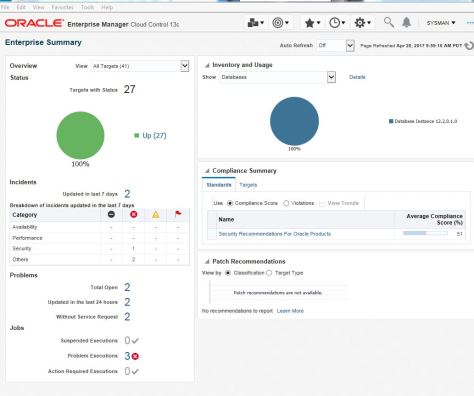
Relatively easy installation, a new learning curve to master for post-installation maintenance and patching.
The principal changes in Release 2 of 13c are the segregation of the Cloud Management Services plugins (and related functionality) to specific licensable plugin components – namely:
- Cloud Services Management – used for provisioning, allocation, and administration (think “infrastructure”) of Oracle Public Cloud-based resources (databases, development tools, middleware, etc.)
- Oracle Cloud Application – a portal punch-out to access Oracle Cloud-based applications such as hosted e-Business Suite, Cloud Content Management, Cloud SOA Suite, Cloud Identity Management, etc. (think “apps”.)
- Cloud Framework – a repackaging of the EM OMS framework components, and the only portion of the “cloud” components included in the base OEM licensing.
Installation guide: http://www.oracle.com/technetwork/oem/grid-control/documentation/oem-091904.html

This proof-of-concept testbed system was based upon the latest available installer set – Oracle Enterprise Manager Cloud Control 13c Release 2 Plug-in Update 1 (13.2.0.0) – we happen to be testing backwards-compatibility with some 10g databases before committing to the upgrade. Direct (out-of-place) upgrades are supported for version of EM 12.1.0.4 and newer.

Fusion Middleware in this release is Weblogic 12.1.3
The host system is built upon Windows Server 2012 R2, single-tier, 16GB RAM, 2 cores, also hosting the OMS repository database in a 12.2.0.1.0 EE installation. Since the DB Templates provided seemed to be specific for a 12.1.x database (and errors out in certain steps during the build), I simply created a generic database from the standard template with the pre-requisite parameter settings (e.g. _allow_insert_with_update_check=TRUE; sessions > 300; shared_pool_size (10% of SGA); etc.) , and pre-created the required tablespaces:
MGMT_AD4J_TS
MGMT_ECM_DEPOT_TS
MGMT_TABLESPACE
During the installation, the (Oracle Universal Installer) OUI will create the following new users assigned to these tablespaces:
Open:
SYSMAN
SYSMAN_TYPES
SYSMAN_BIPLATFORM
SYSMAN_STB
SYSMAN_OPSS
SYSMAN_MDS
MGMT_VIEW
Expired & Locked:
CLOUD_ENGINE_USER
CLOUD_SWLIB_USER
EUS_ENGINE_USER
SYSMAN_RO
The standard download set includes a single executable file (.exe or .bin) and several additional ZIP archives. These are to be staged in a single directory, and the ZIP files do NOT need to be pre-extracted.
Overall, the installation was straight-forward and as-documented (despite this being a Windows installation – which usually has its own quirks.) The portion that I feel has the steepest learning curve is post-installation maintenance, and particularly patching. The new tool in 13c, the OMSpatcher (Patchset 19999993 – think of it as a Java wrapper for opatch) was really designed for use specficially in a cloud-based environment and hasn’t been completely polished for use on-premise in smaller installations.
For example, it is designed to rely upon an active Weblogic AdminServer to instantiate it’s requests for inventory versioning information and component availability for patching. But if any of those components are actually in-use by the AdminServer itself, it will tend to fail to apply, and instead provide a lengthy step-by-step instruction set of how to accomplish all of the steps manually. Depending on the complexity of your OEM setup (e.g. the number of registered plugins and target types) this could take over an hour to get the patching utility to fail and then provide the manual steps.
The OEM-specific version of OPatch (Patchset 6880880) is quite different than its predecessors. While the OMSPatcher uses the prior “unzip into the existing Oracle Home” installation technique, the OPatch utility itself now is a Java installer that relies on the OUI to allow updating of component versioning and inventory adjustments. Most importantly, you will need to “install” the new version of OPatch before being allowed to continue with your planned patching:
$JAVA_PATH\java -jar $PATCH_STAGE\6880880\opatch_generic.jar -silent oracle_home=$ORACLE_HOME (being updated for OPatch)
This OPatch update needs to be applied (before patching) to every Oracle Home using 13c technology (the OMS home, the Agent Home, other FMW homes at version 12.1.3 or newer, etc.)
See MOS EM 13c: How to Apply a Patch to the Enterprise Manager 13c Cloud Control OMS Oracle Home (Doc ID 2091619.1) for details about making an OMSPatcher property file, and why you want to create one.
Final steps executed:
Build general purpose 12.2.0.1.0 database with new tablespaces.
Install Oracle Enterprise Manager Cloud Control 13c Release 2 Plug-in Update 1 (13.2.0.0)
Patch 19999993: EM OMSPatcher latest version 13.8.0.0.2 (unzip to ORACLE_HOME)
Patch 6880880: EM OPatch latest version 13.9.0.0.0 (both OMS and Agent)
cd $PATCH_STAGE\<patch#> $FMW_HOME\OMSPatcher\omspatcher apply -analyze -property_file $FMW_HOME\OMSPatcher\omspatcher apply -property_file [OMS_DISABLE_HOST_CHECK=true -- a useful option added to deal with virtual host names]
Patch 25163555: Tracking bug for Back-porting 24588124 oms side fix
Patch 25604219: MERGE REQUEST ON TOP OF 13.2.0.0.0 FOR BUGS 25497622 25497731 25506784
Patch 25387277: APR-2017 PSU OMS 13.2.0.0.170418
Patch 25162444: EM-BEACON Bundle Patch 13.2.0.0.161231 (Agent)
Patch 25580746: EM-AGENT Bundle Patch 13.2.0.0.170331 (Agent)
Other useful references:
Enterprise Manager 13.2 Master Bundle Patch List (Doc ID 2219797.1)
13.2.0.0.170418 Enterprise Manager Base Platform Patch Set Update (PSU) Readme for Oracle Management Server (OMS) (Doc ID 2246778.1)
